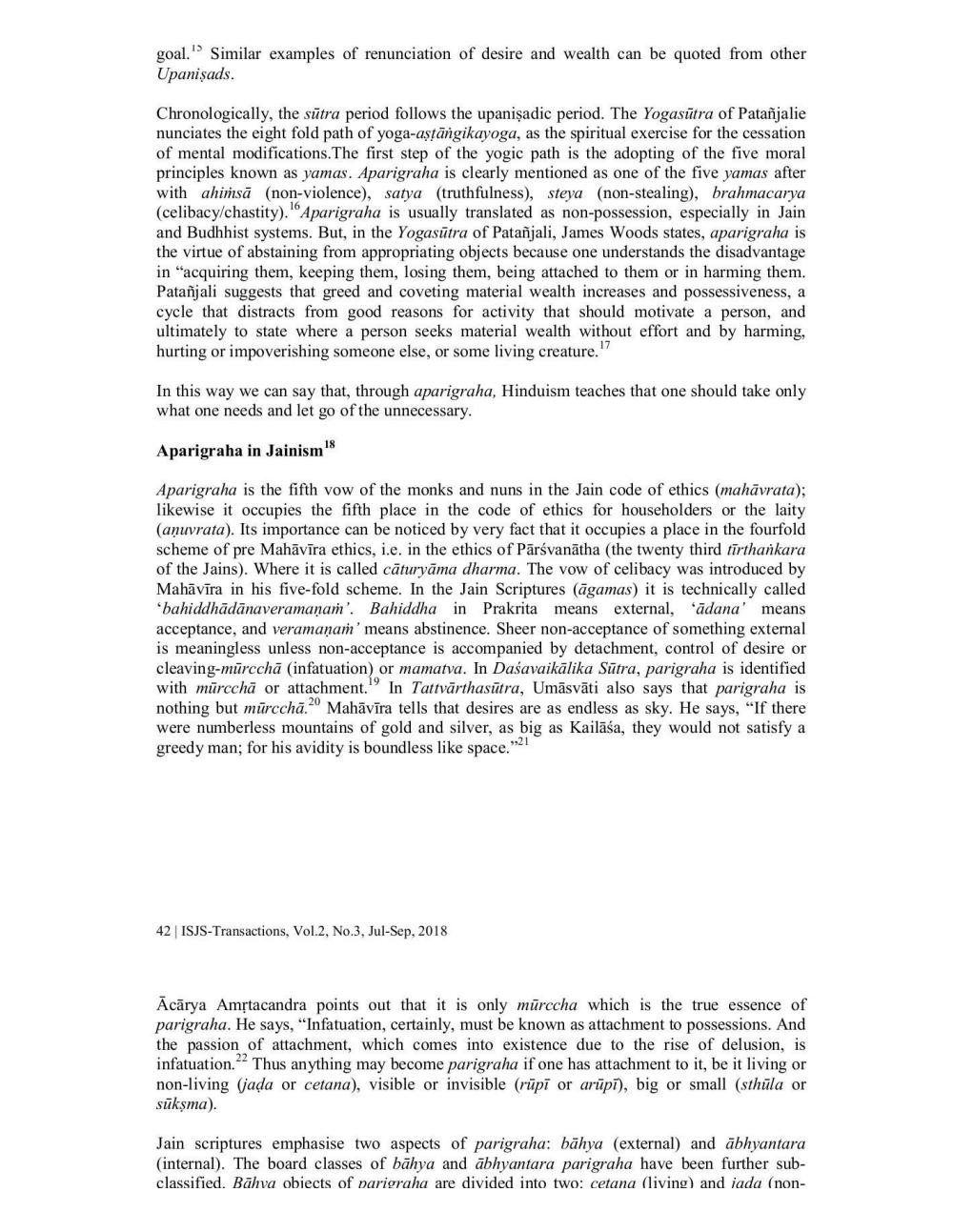________________
goal." Similar examples of renunciation of desire and wealth can be quoted from other Upanişads.
Chronologically, the sūtra period follows the upanişadic period. The Yogasūtra of Patañjalie nunciates the eight fold path of yoga-astāngikayoga, as the spiritual exercise for the cessation of mental modifications. The first step of the yogic path is the adopting of the five moral principles known as yamas. Aparigraha is clearly mentioned as one of the five yamas after with ahimsā (non-violence), satya (truthfulness), steya (non-stealing), brahmacarya (celibacy/chastity). "Aparigraha is usually translated as non-possession, especially in Jain and Budhhist systems. But, in the Yogasūtra of Patañjali, James Woods states, aparigraha is the virtue of abstaining from appropriating objects because one understands the disadvantage in "acquiring them, keeping them, losing them, being attached to them or in harming them. Patañjali suggests that greed and coveting material wealth increases and possessiveness, a cycle that distracts from good reasons for activity that should motivate a person, and ultimately to state where a person seeks material wealth without effort and by harming, hurting or impoverishing someone else, or some living creature."
In this way we can say that, through aparigraha, Hinduism teaches that one should take only what one needs and let go of the unnecessary.
Aparigraha in Jainism 18
Aparigraha is the fifth vow of the monks and nuns in the Jain code of ethics (mahāvrata): likewise it occupies the fifth place in the code of ethics for householders or the laity (aņuvrata). Its importance can be noticed by very fact that it occupies a place in the fourfold scheme of pre Mahāvīra ethics, i.e. in the ethics of Pārsvanātha (the twenty third tirthankara of the Jains). Where it is called cāturyāma dharma. The vow of celibacy was introduced by Mahāvīra in his five-fold scheme. In the Jain Scriptures (āgamas) it is technically called 'bahiddhādānaveramanam'. Bahiddha in Prakrita means external, ādana' means acceptance, and veramanam' means abstinence. Sheer non-acceptance of something external is meaningless unless non-acceptance is accompanied by detachment, control of desire or cleaving-mūrcchā (infatuation) or mamatva. In Daśavaikālika Sūtra, parigraha is identified with mürccha or attachment." In Tattvārthasūtra, Umāsvāti also says that parigraha is nothing but mūrcchā. Mahāvīra tells that desires are as endless as sky. He says, "If there were numberless mountains of gold and silver, as big as Kailāśa, they would not satisfy a greedy man; for his avidity is boundless like space."
42 ISJS-Transactions, Vol.2, No.3, Jul-Sep, 2018
Ācārya Amrtacandra points out that it is only mūrccha which is the true essence of parigraha. He says, "Infatuation, certainly, must be known as attachment to possessions. And the passion of attachment, which comes into existence due to the rise of delusion, is infatuation."- Thus anything may become parigraha if one has attachment to it, be it living or non-living (jada or cetana), visible or invisible (rūpi or arūpī), big or small (sthūla or sūksma).
Jain scriptures emphasise two aspects of parigraha: bāhya (external) and abhyantara (internal). The board classes of bāhya and abhyantara parigraha have been further subclassified. Bāhva obiects of parigraha are divided into two: cetana (living) and iada (non




